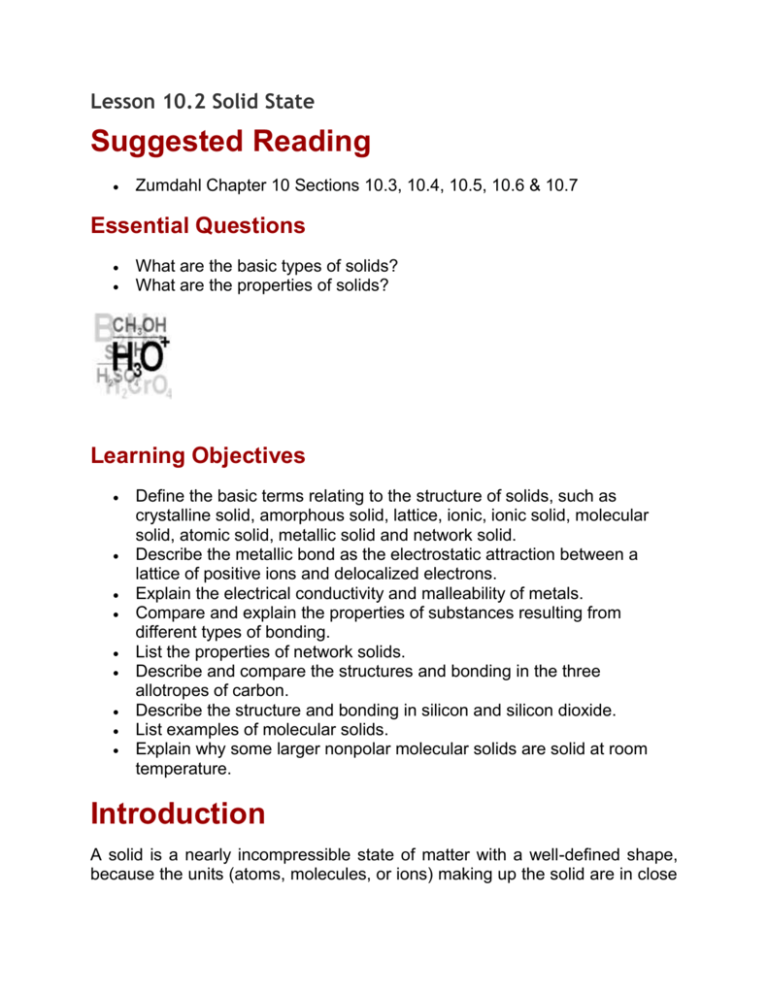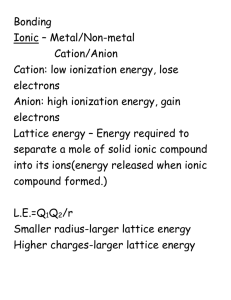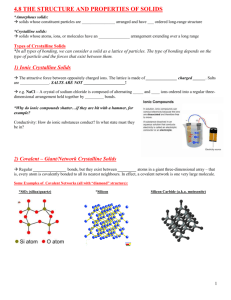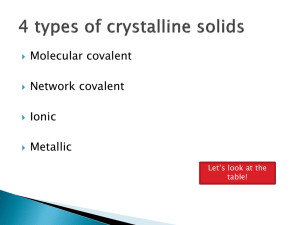Lesson 10.2 solid state
advertisement

Lesson 10.2 Solid State Suggested Reading Zumdahl Chapter 10 Sections 10.3, 10.4, 10.5, 10.6 & 10.7 Essential Questions What are the basic types of solids? What are the properties of solids? Learning Objectives Define the basic terms relating to the structure of solids, such as crystalline solid, amorphous solid, lattice, ionic, ionic solid, molecular solid, atomic solid, metallic solid and network solid. Describe the metallic bond as the electrostatic attraction between a lattice of positive ions and delocalized electrons. Explain the electrical conductivity and malleability of metals. Compare and explain the properties of substances resulting from different types of bonding. List the properties of network solids. Describe and compare the structures and bonding in the three allotropes of carbon. Describe the structure and bonding in silicon and silicon dioxide. List examples of molecular solids. Explain why some larger nonpolar molecular solids are solid at room temperature. Introduction A solid is a nearly incompressible state of matter with a well-defined shape, because the units (atoms, molecules, or ions) making up the solid are in close contact and in fixed positions. In this lesson, we will look at the different kinds of solids and their basic properties. Blending the IB and AP curriculums with respect to this topic creates a hodge podge of concepts. In order to avoid confusion, I will take each learning objective one at a time. This topic is more qualitative in nature, so I strongly suggest making flash cards for this content. Define the basic terms relating to the structure of solids, such as crystalline solid, amorphous solid, lattice, ionic, ionic solid, molecular solid, atomic solid, metallic solid and network solid: There are several types of solid you should have a cursory understanding of. There are many ways to classify solids, but the two broadest categories are amorphous solids and crystalline solids. Amorphous solid: A solid that has a disordered structure; it lacks the welldefined arrangement of basic using (atoms, molecules, or ions) found in a crystal. Glass, SiO2,is an amorphous solid obtained by cooling a liquid rapidly enough that its basic units are frozen in place before they can adopt an ordered crystalline structure. Crystalline solid: A solid composed of one or more crystals; each crystal has a well-defined ordered structure in three dimensions. Recall that the regular, periodic arrangement of ions or molecules in a crystalline solid is called a lattice. There are four subcategories of crystalline solids, which are ionic, molecular, metallic, and covalent network solids. Crystalline solids are defined by the type of bonding as well as the chemical species (molecule, ion, or atom) that resides at each lattice point. Pay attention to this. Types of Crystalline Solids: Ionic solid: A crystalline solid that consists of ions (cations and anions) held together by the electrical attraction of opposite charges (ionic bonds). Examples are cesium chloride and sodium chloride. Molecular solid: A crystalline solid that consists molecules held together by intermolecular forces. Many solids are of this type. Examples are water (ice) and solid carbon dioxide (dry ice). Metallic solid: A solid that consists of positive cores (nuclei) of atoms held together by a surrounding "sea" of electrons (metallic bonding). In this kind of bonding, positively charged atomic cores are surrounded by delocalized electrons. Examples include iron, copper, and silver. Covalent Network solid (Network Solid): A solid that consists of atoms held together in large networks or chains by covalent bonds. Diamond is an example of a network solid. Atomic solid: The term atomic solid is used to describe solids that contains atoms at the lattice points, such as metallic and network solids. Describe the metallic bond as the electrostatic attraction between a lattice of positive ions and delocalized electrons: "When the atoms of metals bond together in the solid state, one or more of their valence electrons becomes detached from each atom to become delocalized. These valence electrons are no longer associated with a particular atom, but are free to move throughout the metallic structure. The bonding in metals thus consists of the attraction between these delocalized valence electrons and the remaining positive metals ions (cations). It is sometimes said that metals are made up of an array of cations in a "sea" of mobile electrons" (Neuss, 2010). Explain the electrical conductivity and malleability of metals: Many physical properties of solids can be directly related to structure. Lets look at a few of these properties. Hardness and Structure Hardness depends on how easily the structural units of a solid can be moved relative to one another and therefore on the strength of the attractive forces between the units. Molecular solids have weak intermolecular forces, so they are softer than ionic solids which have stronger intermolecular forces. A threedimensional covalent network solid is usually quite hard because of the the strong covalent bonds throughout it make it very rigid. In fact, the covalent network solids diamond and silicon carbide (SiC) are among the hardest substances known. Molecular and ionic crystals tend to be brittle because they fracture easily along the crystal planes. Metallic crystals tend to be malleable, which means they can be shaped by hammering. The metal ions in the electron sea model can be easily moved around as the metal is hammered into a sheet or pulled into a wire. Electrical Conductivity and Structure One of the characteristic properties of metals is good electrical conductivity. The delocalized valence electrons are easily moved by an electrical field and are responsible for carrying the electric current. By contrast, most covalent and ionic solids are nonconductors, because the electrons are localized to particular atoms or bonds. Ionic substances do become conducting in the liquid state, however, because the ions can move. In an ionic solid it is the ions, and not the electrons, that carry the charge. Melting Point and Structure For a solid to melt, the forces holding the structural units in their sites must be overcome, at least partially. In a molecular solid, these forces are weak intermolecular attractions so molecular solids tend to have low melting points (usually below 300∘C). At room temperature, many molecular substances are either liquids (such as water and ethanol) or gases (such as carbon dioxide and ammonia). Note, that the melting points reflect the strengths of intermolecular attractions, just as boiling points do. For ionic solids and covalent network solids to melt, chemical bonds must be broken. For that reason, the melting points of these types of solids are relatively high. In ionic solids, the melting point increases with lattice energy. Recall that the lattice energy is the energy needed to separate a crystal into its isolated ions in the gaseous state. Please note that both molecular and covalent network solids have covalent bonds, but none of the covalent bonds are broken during the melting of a molecular solid. Metals often have high melting points, but there is considerable variability. Mercury melts at -39∘C (There is a typo in the chart below, the value for mercury should be negative.). Tungsten melts at 3410∘C, which is the highest melting point of any metallic element. In general, melting points are low for the Groups IA and IIA elements but increase as you move across the periodic table to the transition metals. The elements in the center of the transition series have high melting points. Then, as you move farther to the right, the melting points decrease and are again low for the Group IIB elements. The strength of the metallic bond depends upon the number of unpaired electrons in the valence shell of the atom. The greater the number of unpaired electrons, the stronger the metallic bonding. In any transition element series, the number of unpaired electrons first increases from 1 to 5 and then decreases back to the zero .The maximum five unpaired electrons occurs in the middle of the d-block. As a result, the melting and boiling points first increase and then decrease showing maxima around the middle of the series. Compare and explain the properties of substances resulting from different types of bonding: The physical properties of compounds are determined by a variety of factors, and one of the most important is the type of bond holding the compound together. These properties are listed below for metallic, ionic, and covalent ionic bonding (Make flash cards!). Metallic Metals are characterized by metallic bonding (electron sea model). You should be able to explain each of these properties in terms of the electron sea model, which is characterized by very strong IMFs due to the delocalization of the electrons. Lustrousness (shininess) also results from the delocalization of electrons. Metals are shiny because the delocalized electrons absorb energy easy, which causes them to vibrate. This vibrational energy is then reemitted as visible light (This is what Planck studied. Remember him and his constant? Quantization of energy? If this sounds foggy please review Chapter 7 on atomic structure. Your AP exam will be here before you know it!). Metals are soluble in non-polar solvents, but not water, because metals are nonpolar substances. Remember, "like dissolves like". Malleable solid High melting point and boiling point Insoluble in water Insoluble in nonpolar solvents Conducts heat and electricity Lustrous Examples: gold, copper Ionic Ionic bonds also have very strong IMFs, which is reflected in the properties of ionic compounds. These compounds are also polar, which explains their patterns of solubility. The electrons in ionic compounds are localized in ionic bonds, so they are not free to move about. This makes ionic compounds poor conductors of heat and electricity and brittle rather than malleable like metallic solids. Ionic Solid Very high melting point Soluble in water Insoluble in nonpolar solvents Nonconductor of heat and electricity Conducts electricity in aqueous solutions when dissolved into ions Examples: NaCl, CaCO3 Non-polar Covalent The properties of non-polar covalent compounds reflect the fact that these compounds have localized electrons. Furthermore, they only experience dispersion forces, which are the weakest forces. Gas, liquid, or a soft solid Low melting point and low boiling point (volatile) Insoluble in water Soluble in nonpolar solvents Nonconductor of heat and electricity Nonlustrous Polar Covalent Gas, liquid, or a soft solid Higher melting and boiling points (less-volatile) than non-polar covalent More soluble in polar solvents than non-polar covalent Nonconductor of heat and electricity Nonlustrous List the properties of network solids: Network solids are macromolecules, giant structures of covalentlybonded atoms in one, two or three dimensional arrays. Much like an ionic crystal, the intermolecular bonds are the same as the intramolecular bonds (covalent bonds). Due to the very strong bonds, these solids will have the following properties: Very high melting and boiling points Solids at room temperature Extremely hard Not soluble in polar or nonpolar solvents Nonconductors of electricity Examples: diamond & silicon dioxide Describe and compare the structures and bonding in the three allotropes of carbon: You should be able to describe the bonding around the central carbon atom in terms of the molecular geometry and hybridization around the central atom (Please review Chapters 8 & 9 if you feel rusty on this topic). Diamond: Each carbon in a diamond crystal is bonded to four other carbon atoms making a giant macromolecule. Since each carbon has four single bonds, it is sp3 hybridized and has tetrahedral bond angles of 109º. Graphite: Like diamond, the carbon atoms are bonded together to make a giant structure but in this case all of the carbons are bonded to only three neighbors and are sp2 hybridized. Because the sp2 hybridization results in planar structures, there are giant 2 layers of carbon atoms and each layer is weakly linked to the next layer by van der Waal's forces. Fullerenes: These are molecules of carbon in which the structures are spheres of atoms (bucky balls) or tubes (sometimes called nano-tubes). The smallest fullerene has 60 carbon atoms arranged in pentagons and hexagons like a football. This is called Buckminsterfullerene. The bonding has delocalised pi bonds extending throughout the structure and the carbon atoms are a mixture of sp2 and sp3 hybridization. Thornley's Video on this topic: Watch the following You Tube Video: https://www.youtube.com/watch?v=GIHmfBsHsCY This video is an excerpt of a lecture from MIT given by Dr. Sadoway. He is teaching an engineering course about materials science and compare diamond and graphite in this lecture. I thought you might be interested to see how its done big leagues. Watch the following You Tube Video: https://www.youtube.com/watch?v=X6Ilrw32EKI Describe the structure and bonding in silicon and silicon dioxide: Silicon is found in abundance in the earth's crust. Zumdahl says on page 446 that "silicon is to geology as carbon is to biology". This should give you some idea of the importance of silicon in the natural word. However, unlike carbon which forms chains of C-C bonds, silicon usually forms chains of Si-O bonds. Therefore, its properties are quite different from carbon. Silicon is found in a variety of compounds including quartz and sand. Silicon in quartz exists as silicon dioxide, which is the basic and most common silicon-oxygen compound. Quartz can be melted and then cooled rapidly to make glass, an amorphous solid. Both silicon and silicon dioxide have a diamond structure. Thus, these are giant network covalent structures, with the covalent bonding from atom to atom in a never ending array. Each silicon atom is sp3 hybridized and had a tetrahedral molecular geometry. The bond angles at each silicon atom are. In silicon dioxide, the oxygen atoms act as bridges between silicon atoms in silicon dioxide. The following video from Thornley does a great job of illustrating the structures of Si and SiO2. Watch the following You Tube Video: https://www.youtube.com/watch?v=PiYnQLI-ufU List examples of molecular solids: Ice Dry ice (CO2) Solid neon Sucrose (table sugar) Solid Iodine Polyethylene Hydrocarbons To name a few! Explain why some larger nonpolar molecular solids are solid at room temperature: Since non-polar substances only have dispersion forces, you might not expect solid non-polar molecules to exist at room temperature. Recall that dispersion forces are very week compared to other types of IMFs. However, larger and heavier atoms and molecules exhibit stronger dispersion forces than smaller and lighter ones. In a larger atom or molecule, the valence electrons are, on average, farther from the nuclei than in a smaller atom or molecule. They are less tightly held and can more easily form temporary dipoles. The dispersion forces in larger molecules are quite significant, which results in some larger non-polar molecular solids at room temperature, especially hydrocarbons.







